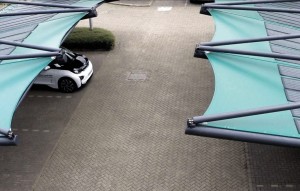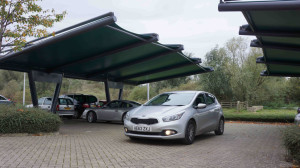
Solar Cloth Company eyes growth with Base Structures merger.
Flexible, fabric-based solar cells have intrigued the energy and advanced technical textiles industries for years. Smaller niche markets, cleverly deployed prototypes and high-fashion applications have used flexible photovoltaics (PV), often with success. Larger-scale solar fabric applications with true commercial viability … that has been more elusive. But Solar Cloth Company (SCC), based in the U.K, believes the market for flexible PV on a larger scale is there—and the technology is ready to meet the demand.
SCC has been commercially active for just over a year and a half. “A fundamentally specialist PV integrator,” says CEO Mike Staplehurst, it recently merged with Base Structures, also based in the U.K., which designs, manufactures and installs fabric structures. Among them are the “Up at the O2” walkway on the Millennium Dome in London and the Ben Ainslie Racing headquarters at Portsmouth.
“The two firms will use the merger to focus on the deployment of solar carports in the U.K,” says Staplehurst. “By combining the two companies’ expertise, it will be possible to integrate renewable energy generation into elegant fabric structures at a competitive price point and without compromising on design or aesthetics.”
It’s a working relationship that grew into a merger. “We’re PV specialists, but not necessarily the best in the world doing tensile structures,” Staplehurst says. “We realized that if you want to take a flexible, lightweight PV, you need to understand how to work with fabric materials, so we worked with Base Structures.”
Base has a 10-year pedigree in the fabric structures industry, “Probably number one in the U.K. in buildings,” he says. “Base is doing a lot more in the building industry and is very good at making unique structures,” he says. And they understand the applicable building regulations.
“They were looking at us, and they said ‘you bring something completely new to this business,’” he says. “We realized that we’re addressing the building market and they’re addressing the building market; we can do something completely unique together.”
SCC soon discovered that there were “a huge number of market overlaps,” he says. “It got us thinking. We needed them for their capabilities and understanding of fabrics. They were looking at us as someone who could take them a step forward—lots of synergies on lots of levels: technical, resources, capabilities and deployment. Bringing the two together made good sense.”
 SCC uses lightweight flexible TFPV modules, specializing in applying the modules through bonding, or fabric welding techniques to the surface of the fabric or the structure. The company concentrates on “CIGS” (copper indium gallium selenide) technology because it’s extremely lightweight and flexible. This makes it functional for structures with lightweight roofing—structures that can’t support any heavy weight, or may have constraints on penetration, or that aren’t square or flat.
SCC uses lightweight flexible TFPV modules, specializing in applying the modules through bonding, or fabric welding techniques to the surface of the fabric or the structure. The company concentrates on “CIGS” (copper indium gallium selenide) technology because it’s extremely lightweight and flexible. This makes it functional for structures with lightweight roofing—structures that can’t support any heavy weight, or may have constraints on penetration, or that aren’t square or flat.
“This brought up the point of working out a method to deploy solar roofing on this scale,” he says, and the company looked more closely at canopies, particularly for carport systems. “This is where the nascent market is—in carport systems.”
Staplehurst says that the solar industry in the U.K. is paying more attention to fabric-based technologies, rather than steel or glass. Improved efficiencies have made it possible for flexible PV materials to compete on a larger scale, which also brings down the cost. “Most were deployed in specialty areas, like Space or niche markets where you can command a high value,” he says. Now flexible technologies like CIGS are “starting to come into the commercial envelope,” he says, and they can deliver the power levels needed at a commercially viable price point.
“There’s a bit of a different dynamic in the industry now, too,” he says. “The emphasis is on demand side energy management rather than supply side (grid): your price point is significantly higher than grid price, but people are now starting to look at reducing their own energy requirements (dealing with consumer-level prices, not grid level prices) and given that they’re looking at it as a long-term asset, you have a market,” he says.
“For example, a commercial building that consumes a lot of power is connected to the grid. So where can you generate electricity?” he asks. “Your parking. Now you can introduce solar power at a price point that’s competitive.” Branding for commercial clients is also important, and there is a growing pool of potential customers that want it not only for its practical value but for its cachet, too.
“Lightweight solar is going to completely change how a company deploys the use of solar energy,” he says. “We are a new kid on the block, but Base [Structures] has been around 10 years. It’s the combination that will differentiate us in the market.”
Janet Preus is senior editor of Advanced Textiles Source.
 TEXTILES.ORG
TEXTILES.ORG


